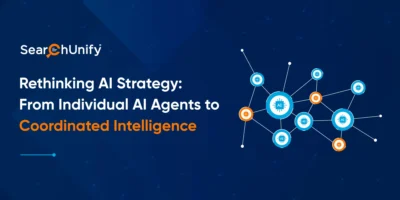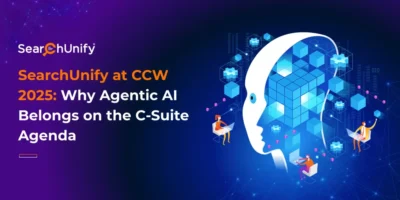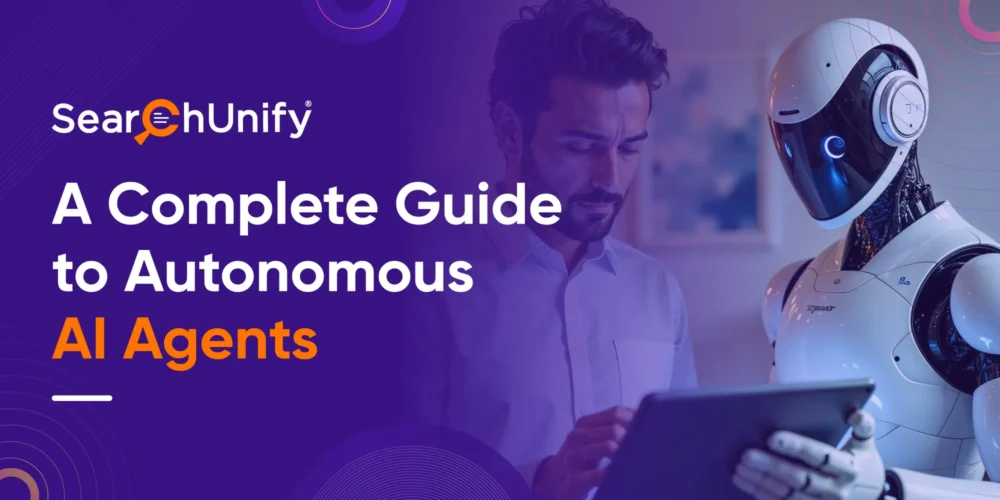
This signals an increased investment in autonomous AI solutions to stay ahead of the competitive curve. But, the question is what exactly these autonomous AI agents are, and how they are different from conversational AI solutions?
And most importantly, how can businesses leverage this technology to transform their business operations?
Let’s get started.
What are Autonomous AI agents?
Autonomous AI agents are an advanced form of AI that not only respond to and understand customer queries but also take action without any need for human intervention. When an objective and a goal is defined, they act autonomously and ensure that the goal is achieved. These agents:
- Can operate in dynamic environments, making them ideal for executing complex tasks.
- Need human intervention only at the time of establishing the goal and main objective.
- Leverage technologies like Machine learning, natural language processing, and real-time data analysis to execute tasks.
- Uses tools and memory to act autonomously, tools include LLMs or external sources such as websites, databases, or other knowledge bases. Memory refers to learning from experiences, such as past interactions or past outputs, to continuously improve.
Key Characteristics of Autonomous AI Agents?
Autonomous AI agents vary widely in their capabilities—some are designed to accomplish highly specialized tasks with precision, while others are built with broader, more adaptive intelligence to tackle a range of goals. In either case, before finding the right agent for a specific business, it is important to understand the key characteristics of these agents:
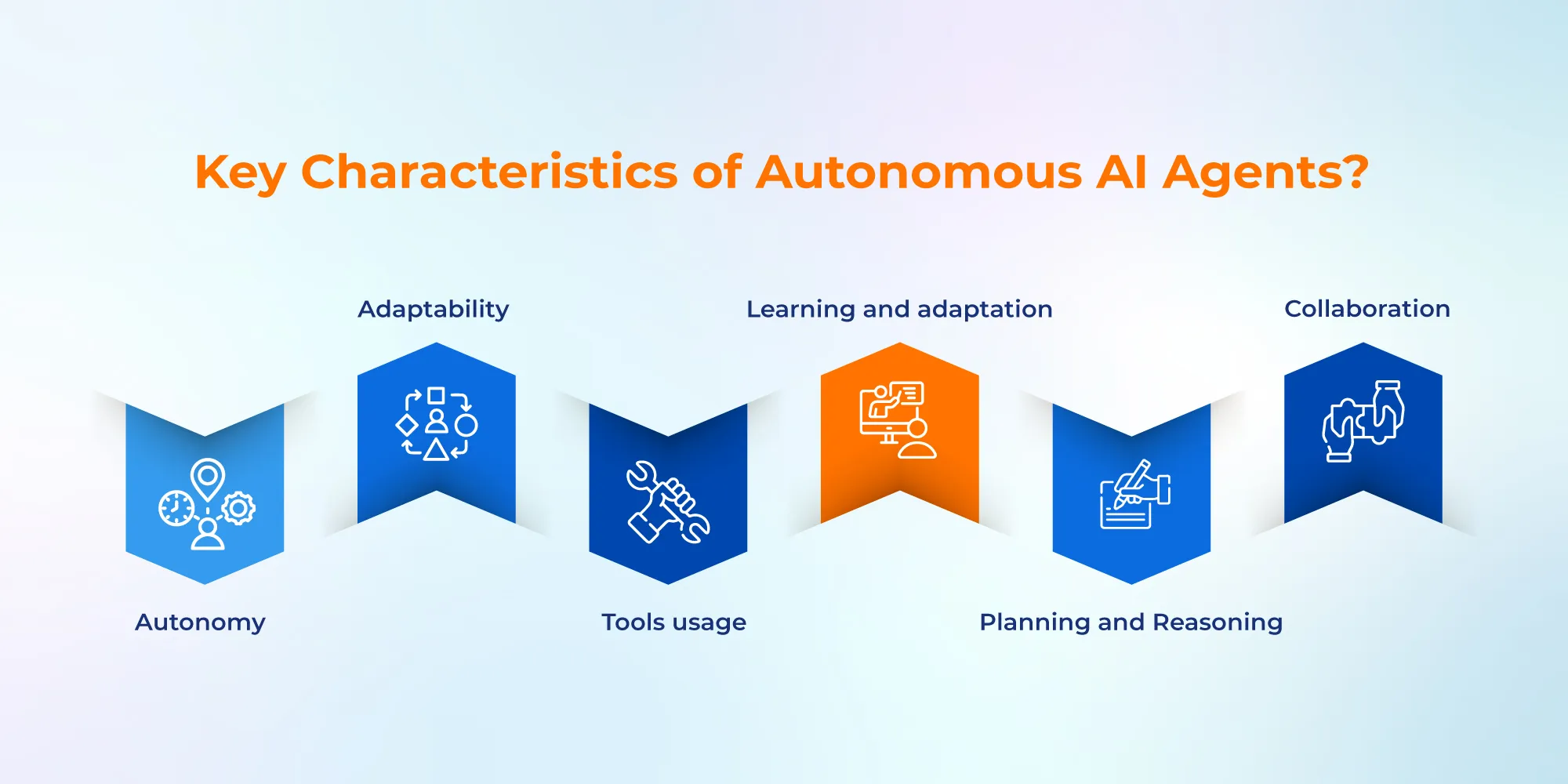
- Autonomy: Autonomous AI agents are known for their ability to complete tasks without the need for any human intervention. They act autonomously, reducing the workload of agents.
- Adaptability: These agents are designed to work in a dynamic environment and adjust their behaviour as per the opportunities, adapting to the evolving needs of business.
- Tools usage: To act autonomously, these agents need tools such as LLMs, external data sources, or knowledge bases from which they extract information and utilize it to execute tasks.
- Learning and adaptation: These agents learn and adapt from past interactions and past outputs that go into their memory and can be used in the future.
- Planning and Reasoning: Once a goal and objective are defined, these agents are capable of planning the next steps involved in the execution and thinking strategically to achieve these goals.
- Collaboration: These agents collaborate with other agents as well in a multi-agent system, to achieve complex goals with ease, taking customer service to the next level.
How Do They Work?
Autonomous AI agents leverage technologies like natural language processing, machine learning and real-time data analysis to perform operations. Let’s understand how these agents work:
- Perception and data collection: These agents first gather the information required for understanding the context behind the task. These data sources can be past interactions, external or internal databases, it can also include structured or unstructured data. Once the data is gathered, they utilize this data to make informed decisions.
- Processing and Decision Making: Once the data is collected, they leverage machine learning and deep learning to analyze the patterns and make predictions from the data. Thus, the information so collected is then utilized to make decisions that align with the goal and objectives defined. For example, while responding to a customer, an autonomous AI agent analyzes the past interactions to understand the customer’s pain point and respond accordingly.
- Action Execution: Once the decision is made, the next step for these agents is to execute the task as per the defined objective, which can be processing payment requests, providing personalized recommendations to the customer, escalating the complex tickets to human agents, and so on. This execution ensures a seamless customer service experience.
- Learning and Adaptation: These AI agents improve their performance over time by learning and adapting from the interactions using reinforcement learning. They continuously update their knowledge bases and refine their decision-making, making them capable of adapting in a dynamic environment.
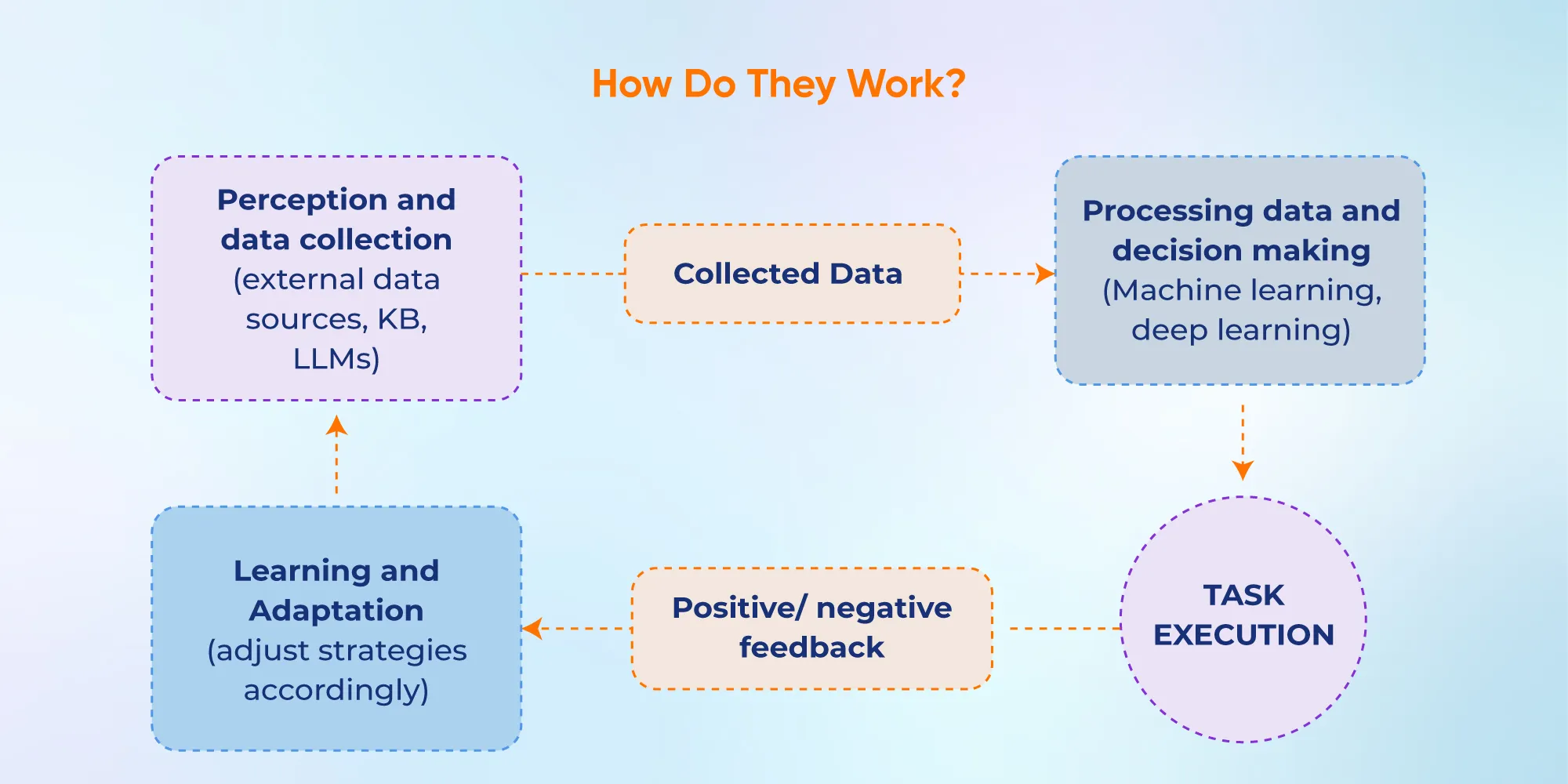
Types of Autonomous AI Agents
All autonomous AI agents are not alike; each of them operates in a different way to meet different objectives. There are various types of autonomous agents. Let us understand them one by one:
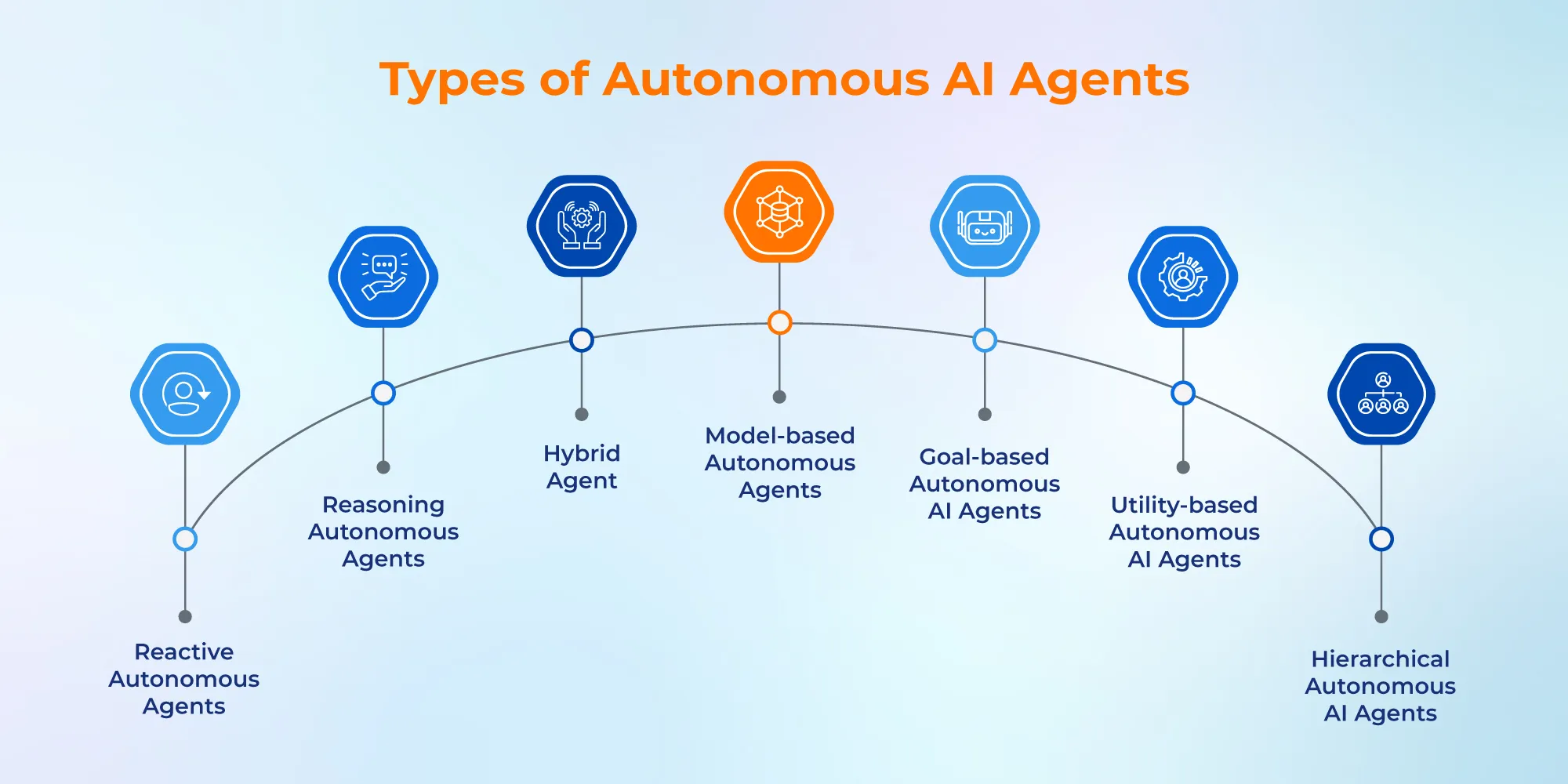
- Reactive Autonomous Agents: These types of AI agents work on a pre-defined set of rules and make decisions based on these specific inputs. These are the simplest form of AI agents that are reactive and do not have any memory of past interactions. This makes them incapable of handling complex queries and working in dynamic environments.
- Reasoning Autonomous Agents: As the name suggests, these agents make decisions by analyzing the environment and plan the next steps accordingly to meet the objective. These agents are also called deliberative or cognitive autonomous agents. They undergo reasoning before deciding anything, weigh options, and analyze the best way to achieve their goals.
- Hybrid Autonomous Agents: These AI agents combine the elements of both the reactive and reasoning autonomous agents to meet the objectives in a dynamic environment. They respond to the changing environment swiftly while focusing on the long-term goals.
- Model-based Autonomous Agents: Model-based AI agents leverage the internal models to adapt in the dynamic business environment. These models not only make decisions but also learn and adapt along the way. These agents also help in making predictions and filling the voids in knowledge bases by continuously adapting to customer interactions.
- Goal-based Autonomous AI Agents: These AI agents go beyond the reactive approach. When a goal is defined, these agents make decisions, plan actions, and find the best approach to achieve that goal. This makes them ideal for achieving long-term goals. Not only this, but in case of a shift in objectives or changes in the environment, they adapt accordingly and make changes swiftly.
- Utility-based Autonomous AI Agents: These AI agents evaluate the actions based on their utility function, ranking the outcomes in a way that will help to achieve the desired objective. Utility-based agents can continuously optimize their performance in real-time based on the set criteria.
- Hierarchical Autonomous AI Agents: These AI agents break a task into sub-tasks for execution and manage the task as per its complexity. By breaking down the task into sub-tasks, they handle the intricate workflows and coordinate multiple operations at a time.
Ready to Deploy these AI Agents?
Connect with us?Autonomous AI agents vs. AI Agents: What’s the difference?
| Factors | AI Agents | Autonomous AI Agents |
| Level of Autonomy | These agents can’t operate without human supervision or trigger-based inputs | These agents can operate independently or autonomously with minimal or no human intervention. |
| Goal Orientation | Follow specific pre-defined instructions or rules for task completion. | Work toward broader objectives with dynamic goal-setting. |
| Adaptability | Limited adaptability; requires retraining or reprogramming. | Continuously learn and adjust based on reinforcement learning and feedback. |
| Decision-Making Ability | Reactive decision-making as it works on pre-defined rules. | Proactive as it is capable of real-time decision-making based on the environment or the context. |
| Learning Mechanism | Often relies on static models | Employs self-learning via deep learning, generative AI, or reinforcement learning |
| Execution Scope | Executes isolated or linear tasks | Can manage end-to-end workflows and multi-step processes autonomously |
| Interactivity | Primarily responds to commands or inputs | Can initiate actions and collaborate with other agents or systems |
| Context Awareness | Limited understanding of dynamic environments | Highly context-aware and can make situational adjustments |
| Examples | Basic chatbots, rule-based virtual assistants, and automated scripts | AutoGPT, AgentGPT, Salesforce’s Autonomous Agents, and real-time customer service agents |
| Business Impact | Enhances task efficiency | Drives transformation through intelligent automation and strategic execution |
Benefits of Autonomous AI Agents in Business
Implementing pre-built autonomous AI agents into your business can benefit it in many ways, starting from improving productivity to increased scalability. Let’s find the advantages of these agents:
- Enhanced Efficiency and Productivity: These AI agents reduce labor costs, particularly for repetitive and mundane tasks. These agents are available around the clock and thus reduce the burden on the agents as well. This allows them to focus on more creative and complex tasks, thereby improving their efficiency and productivity.
- Improved Decision Making: With agents operating in different business functions, it becomes easier to monitor these operations to get a comprehensive picture. The insights that come from one agent can be utilized by other agents for task execution, leading to improved and strategic decision-making.
- Increased Scalability: These agents, being capable of handling the complexities of a dynamic work environment, reduce the need for hiring human resources in bulk. Thus, it becomes easier for businesses to scale without hiring extra human agents as they can blend into the workflows without disrupting the processes.
- Risk Reduction: Autonomous AI agents leveraging deep learning and machine learning are capable of analyzing the patterns and finding the voids or predicting what is coming next. This approach makes them the best fit when it comes to fraud detection or detecting anomalies beforehand. This not only reduces the risk of escalation but also reduces other potential risks as well.
- Continuous Learning and Improvement: These AI agents leverage machine learning and deep learning models to learn from past interactions, feedback, and store them in memory for future reference. This helps them to continuously improve themselves.
Best Practices To Include Autonomous AI Agents in Your Business Strategy
Deploying autonomous AI agents in business operations requires careful planning and execution. Here are the best practices that can help you implement these AI agents in your business:
- Define Clear Objectives: Defining the objective for which you want to implement the autonomous AI agents is a first step. It can be to increase customer satisfaction, to reduce labor costs, or to increase operational efficiency. Once a clear goal is defined, it makes it easier to find the right AI agent for your business.
- Assessing your Data: Autonomous AI agents rely on data for delivering results. In order to get desired outcomes, it’s important to assess the data repositories, whether it is external or internal databases. Structured and clean data will help these AI agents to deliver more effective results.
- Select the Right Architecture: Once you define your objective, it gives you the clarity about the architecture you require to meet that objective. Some may require a reasoning autonomous agent, or others may require a hybrid autonomous agent. This evaluation will help you to find the agent that is the best fit for your business.
- Integration with existing systems: Another consideration is to implement the autonomous agents that can integrate seamlessly with your existing CRM systems. This seamless integration is crucial for smooth informational flow and enhancing the capabilities of AI agents to retrieve the relevant information and provide effective support.
- Focus on Customer experience: While making the decision, always keep the end user in mind. Customers need intuitive and accurate responses; to do so, ensure that these agents cater to the needs of the customer and deliver a positive customer service experience. Test your agents and find if there is any bottleneck that needs to be addressed to ensure smooth customer interactions.
- Plan for Human oversight: Although these agents can work autonomously, but ensure that there is room for human oversight and intervention whenever needed. In case of complex and sensitive cases, it is better to ensure that there are proper guidelines for human intervention, ensuring safety.
- Ensure data privacy and security: While implementing these autonomous AI agents in the workflows, ensure there is a proper governance layer to protect the sensitive information of the customers. This can also include regular security audits and strict privacy and security regulations to safeguard customer information and maintain trust.
Limitations of Autonomous AI Agents
Although the introduction of autonomous AI agents is playing a transformative role in business but nothing comes without limitations. Here are a few limitations of these AI agents that businesses need to consider while implementing these agents:
- Data Intensive Nature
Although these agents work autonomously but, to generate responses and deliver the desired outcomes, they need data and are dependent on the data they are fed. The biases in data can directly impact the quality of the outcomes and thus impact the business operations as well. - High Computational and Resource Costs
Autonomous agents require significant computational power, memory, and energy, especially when processing real-time data or executing complex multi-step tasks. This makes implementation expensive and potentially unsustainable for smaller enterprises. - Black Box problem
Many autonomous AI agents, especially those powered by deep learning, operate as “black boxes”, making it difficult to understand how decisions are made. This lack of transparency can be a major roadblock in regulated industries or high-stakes environments where explainability is crucial. - Security and Control Risks
Operating with a high level of autonomy introduces cybersecurity risks. If not properly secured, these agents could be manipulated, behave unpredictably, or even cause system-wide failures, especially if they interact with other automated systems.
Use Cases of Autonomous AI Agents
- Autonomous AI agents for lead qualification and prioritization
By integrating autonomous AI agents with CRMs and marketing automation tools, it becomes easier for the sales team to analyze the leads. These agents rank all of the leads analyzed at various touch points based on their likelihood to convert, helping the sales team to focus their efforts on those leads. - Autonomous AI agents for Autonomous Campaign management
These AI agents can be used to manage the digital marketing campaigns, including social media and Google Ads. These agents are capable of automatically adjusting bids, ad creatives based on real-time performance data to maximize ROI and achieve campaign goals. - Autonomous AI Agents for Proactive Support
These agents are not just capable of handling customer queries but also leveraging machine learning algorithms that can analyze the customer journey to understand various touchpoints and predict the issues that are likely to occur beforehand. Thus, providing a resolution well in advance before the problem surfaces. - Autonomous AI agents for inventory management and demand forecasting
These agents are capable of analyzing the historical data of sales, seasonal trends, marketing campaigns, and external factors to predict the demand with high accuracy. This can help businesses manage the inventory and reduce storage costs, and prevent stockouts. - Autonomous AI agents for fraud detection and prevention
These agents can analyze the transaction data and identify the patterns in the financial data. Thus, they can detect the fraud in advance so that it can be prevented. Not only this, they can also track the system logs and monitor the network traffic to detect suspicious activities and potential cybersecurity risks in real-time.
Future of Autonomous AI Agents
The future of these autonomous AI agents seems bright. Here is what we can expect in future:
- Rise of Multi-Agent Ecosystems:
Autonomous agents will increasingly collaborate with each other, forming decentralized ecosystems that can co-manage tasks, optimize workflows, and self-organize in real-time. - Wider Enterprise Integration:
Expect seamless integration with core business platforms—CRMs, ERPs, HR systems—enabling autonomous agents to become embedded in day-to-day operations across departments. - Explainable and Auditable AI:
As regulatory demands grow, there will be a push toward building agents with transparent decision-making and built-in compliance frameworks for industries like finance, healthcare, and government. - Adaptive Customer Experience Models:
Customer service will be revolutionized by agents who can not only resolve queries but also proactively anticipate customer needs, personalize interactions, and act as intelligent advisors. - Autonomy with Guardrails:
Organizations will strike a balance between agent independence and human oversight through autonomy control layers, ensuring accountability, safety, and ethical alignment.
Final Thoughts
Autonomous AI agents represent a transformative leap in artificial intelligence, moving beyond basic automation to intelligent, goal-driven execution. As they become more context-aware, self-improving, and capable of working across multi-step workflows, they will redefine what operational excellence looks like in the digital age.
Thus, implementing these agents can give your business an edge over competitors. If you’re evaluating your options to choose the right agent for your business, we are at your service.
Our AI-powered platform goes beyond traditional automation by delivering autonomous support agents that are context-aware, self-learning, and deeply integrated into your ecosystem. Whether you’re streamlining support operations, boosting self-service adoption, or enabling enterprise-wide knowledge discovery, SearchUnify’s intelligent agents adapt and evolve to meet your goals.
Want to see how an autonomous agent can elevate your business outcomes? Let’s talk.
Frequently Asked Questions
1. Are autonomous AI agents safe to use without human supervision?
While they’re designed to operate independently, autonomous AI agents still require guardrails, monitoring, and ethical guidelines to prevent unintended outcomes.
2. Can autonomous AI agents collaborate with human teams?
Yes, many are designed for human-AI collaboration, acting as intelligent co-workers that enhance decision-making, automate repetitive tasks, and provide real-time insights.
3. Do autonomous AI agents need internet connectivity at all times?
Not always. Some agents can operate offline or in edge environments, though their learning and adaptability may improve with cloud connectivity and continuous data access.
4. How are autonomous AI agents trained and updated?
They are typically trained on domain-specific datasets using reinforcement learning or deep learning, and updated through ongoing learning loops and feedback integration.
5. What industries are leading in the adoption of autonomous AI agents?
Industries like finance, manufacturing, logistics, customer service, and healthcare are early adopters—using them for fraud detection, process automation, and predictive maintenance.



